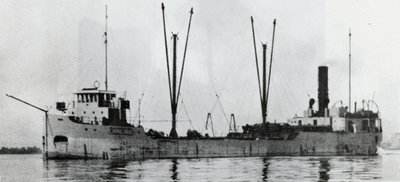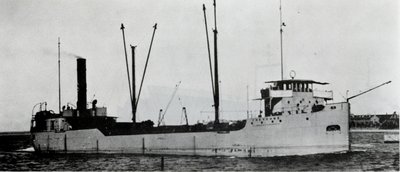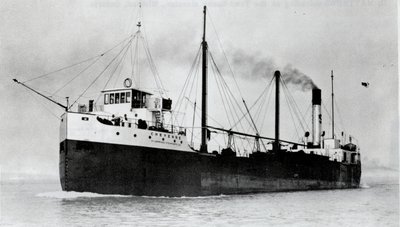Table of Contents
A Brief Corporate History and Fleet List
E. S. Crosby and Company Inc. were grain dealers and elevator operators at Buffalo during the years when that port was a major grain receiving and trans-shipping centre. The company operated the Frontier (Washburn-Crosby) Elevator which was located on the old City Ship Canal just to the north of the Michigan Avenue bridge, and which, to this day, remains as part of the elevator facilities of General Mills Inc.
The Crosby interests realized that much grain had to be unloaded from upper lakers at Buffalo and Port Colborne and then reloaded into canal-sized steamers for the rest of the journey eastward to Montreal and other St. Lawrence River ports. They decided that considerable profit might be made by operating their own canallers in this trade. Accordingly, E.S. Crosby of Kenmore, N.Y., together with attorneys-at-law A. M. Saperston and O. G. Olds of Buffalo, barrister G. H. Pettit of Welland, and T.J. Darby of Humberstone, joined forces early in 1929 to form a Canadian company which could handle these grain shipments through the old canals.
The result was the incorporation of St. Lawrence Steamships Ltd. under the Dominion Companies Act with authorized capital of $250,000. The new firm had its offices at Welland, Ontario, and its first officers were E. S. Crosby of Kenmore, N.Y., president; Thomas H. Hanrahan, Buffalo, vice-president; Ernest S. Crosby, Buffalo, treasurer; A. M. Saperston, Buffalo, secretary, and G. W. Darby, Welland, assistant secretary.
The new company immediately placed orders in Great Britain for the construction of two canallers and, soon afterwards, it purchased two more canallers, of very similar design, which had been built on speculation by a British shipyard and then repossessed from the lake operator who had originally purchased them. These four steamers were the only boats that St. Lawrence Steamships Ltd. ever owned, and they gave the fleet more than a decade of good service, even if they were completed just before the onset of the Great Depression. They carried grain and coal downbound from Lake Erie ports to Montreal and usually returned with cargoes of pulpwood. Although they occasionally called here, they were not frequent visitors to Toronto Harbour.
St. Lawrence Steamships vessels were always distinctive in appearance, but the black-and-white film then in use failed to do justice to the ships' colours and, undoubtedly, has left many of today's historians, who never saw the boats, wondering just how they were painted. Originally, all four ships carried grey hulls, while their forecastles and cabins were buff. Stacks were dark red with a large white letter 'S' and a black smokeband. By about 1938, however, the steamers were appearing with black hulls, white forecastles and cabins, and their stacks silver with a black 'S' and smokeband.
The St. Lawrence Steamships canallers were all equipped with light pole masts and (although perhaps not originally) with kingposts and cargo booms. Despite their contemporary design, however, they came from the shipyards with "sawmill" stacks, funnels that were very thin and of great height. By the late 1930s, these were cut down to more reasonable height. But if their stacks looked old-fashioned, the boats themselves were good carriers and St. Lawrence Steamships took steps to ensure their economic viability. Two of the ships were deepened in 1939 to provide extra carrying capacity, this operation being carried out by raising the whole forward end so as to eliminate the step in the spar deck which was common to most canallers. This left the vessels with a deck which was completely flush from bow to stern, although the forecastles were later raised by subsequent owners to give them back their traditional canaller appearance. This major rebuild ensured their continued operation even after the opening of the St. Lawrence Seaway and, as it developed, these were among the first canallers so improved, although other operators would later apply the same enlargement methods to their own vessels.
Three of the four boats were requisitioned for wartime service on salt water, but none of these were lost abroad. In this detail, the company achieved something of a record, for most canaller owners found that many of their ships were unavailable after the cessation of hostilities, for they had fallen victim either to enemy action or to the rigours of deep-sea service.
All four of the ships continued to run on the lakes after the war, three of them in the Paterson fleet. They all ran well into the 1960s and, in fact, two of them proved to be the last steam canallers operated by Paterson, remaining in service until the close of the 1965 season. They were among the last steam canallers to operate anywhere, and their retirement virtually brought the era of the canaller to a close.
There follows a fleet list, with as much information concerning each of the company's four steamers as we are presently able to assemble:
ALGONQUINS (46), (b) TROISDOC (II) (C.161515). Steel bulk carrier built 1929 at Whiteinch, Glasgow, Scotland, by Barclay Curie and Company Ltd., Hull 631. Launched April, 1929. 252.7 x 43.8 x 17.8, 1938 Gross, 1157 Net. Triple-expansion engine 15", 25", 40" x 33" and two coal-fired single-ended Scotch boilers 10'1 3/8" x 10'10" built by Barclay Curie & Co. Ltd., Glasgow. Built for St. Lawrence Steamships Ltd., Welland. Rebuilt 1939 at Port Dalhousie by Muir Bros. Dry Dock Company Ltd. by removing deck step; deepened to 21.8, 2100 Gross, 1461 Net. Requisitioned 1940 for war service on salt water and later sold to government of Newfoundland. Purchased 1946 by Paterson Steamships Ltd., Fort William, and returned to lake service. Later transferred to N. M. Paterson and Sons Ltd., Fort William. Again given raised forecastle c.1948, 2140 Gross, 1505 Net. By 1954, tonnage increased to 2211 Gross, 1522 Net. Operated until close of 1965 season and then sold to Marine Salvage Ltd., Port Colborne. Laid up at foot of Catherine Street, Hamilton, with SORELDOC. Resold to Steel Company of Canada Ltd. and scrapped at Hamilton 1966.

ALGONQUINS crosses Toronto Bay, heading outbound toward the Eastern Gap. Photo, c. 1936, by J. H. Bascom.
CHEYENNE (46), (a) PHENICIA (31), (c) SORELDOC (II) (C.149498). Steel bulk carrier, built 1929 at Sunderland, England, by Swan Hunter and Wigham Richardson Ltd., Hull 1367. Launched March, 1929. 252.8 x 43.4 x 17.8, 1938 Gross, 1157 Net. Triple-expansion engine 15", 25", 40" x 33" and two coal-fired single-ended Scotch boilers 10'1" x 10'9" built by MacColl and Pollock Ltd., Sunderland. Built on speculation by shipyard. Sold to Kenneth A. Scott, Cleveland, who founded and then managed Inland Lines Ltd., Winnipeg, but later repossessed by shipyard. Subsequently sold to St. Lawrence Steamships Ltd., Welland. Was not requisitioned for war service on salt water. Sold 1946 to Paterson Steamships Ltd., Fort William, and later transferred to N. M. Paterson and Sons Ltd., Fort William. Rebuilt 1946 at Montreal by removing deck step and raising forecastle. New dimensions 253.5 x 43.4 x 21.8, 2210 Gross, 1550 Net. By 1954, tonnage amended to 2214 Gross, 1526 Net. Operated until close of 1965 season and then sold to Marine Salvage Ltd., Port Colborne. Laid up at foot of Catherine Street, Hamilton, with TROISDOC. Resold to Steel Company of Canada Ltd. and scrapped at Hamilton 1966.

CHEYENNE is inbound at the Toronto Western Gap, c1936, in this photo by J. H. Bascom.
DELAWARE (43), (a) IMARI (31), (c) EMPIRE ROTHER (49), (d) MANICOUAGAN (I) (51), (e) WASHINGTON TIMES-HERALD (54), (f) MANITOULIN (C.149497). Steel bulk carrier built 1929 at Sunderland, England, by Swan Hunter and Wigham Richardson Ltd., Hull 1383. Launched March, 1929. 252.8 x 43.4 x 17.8, 1940 Gross, 1158 Net. Triple-expansion engine 15", 25", 40" x 33" and two coal-fired single-ended Scotch boilers 10'0" x 10'9" built by MacColl and Pollock Ltd., Sunderland. Built on speculation by shipyard. Sold to Kenneth A. Scott, Cleveland, who founded and then managed Inland Lines Ltd., Winnipeg, but later repossessed by shipyard. Subsequently sold to St. Lawrence[sic] Steamships Ltd., Welland. Requisitioned for war service on salt water and later chartered by the British Ministry of War Transport to William Cory and Son Ltd., London, England. Purchased October 18, 1948, by the Quebec and Ontario Transportation Company Ltd., Montreal, and returned to lake service in June, 1949. Was never deepened but remained in service for Q & O until laid up at Thorold at close of 1960 season. Towed to Port Weller May, 196l, by tug PORT WELLER, and laid alongside south end of fitout berth at shipyard. Sold to A, Newman and Company, St. Catharines, and towed to Port Dalhousie. Scrapping began August, 1961, in Port Dalhousie drydock.
SIOUX (46), (b) PRESCODOC (II) (C.161516). Steel bulk carrier built 1929 at Whiteinch, Glasgow, Scotland, by Barclay Curie and Company Ltd., Hull 632. Launched April, 1929. 252.7 x 43.3 x 17.8, 1940 Gross, 1160 Net. Triple-expansion engine 15", 25", 40" x 33" and two coal-fired single-ended Scotch boilers 10'1" x 10'10" built by Barclay Curie & Co. Ltd., Glasgow. Built for St. Lawrence Steamships Ltd., Welland. Rebuilt 1939 at Port Dalhousie by Muir Bros. Dry Dock Company Ltd. by removing deck step; deepened to 21.8, 2100 Gross, 1461 Net. Requisitioned 1940 by the Canadian government for war service on salt water. Operated 1942-46 by the United States Maritime Commission. Purchased 1946 by Paterson Steamships Ltd., Fort William, and returned to lake service. Later transferred to N. M. Paterson and Sons Ltd., Fort William. Again given raised forecastle c.1948, 2140 Gross, 1505 Net. By 1954, tonnage altered to 2197 Gross, 1500 Net. Operated until close of 1962 season and laid up at Cardinal, Ontario. Sold 1963 to Western Iron and Metal Company Ltd., Toronto. Arrived at Toronto September 24, 1963, in tow of G. W. ROGERS. Scrapped along west wall of Toronto turning basin during autumn of 1964.
As a sideline to the story of the St. Lawrence Steamships canallers, it is interesting to note that these four steamers were almost identical to yet another pair of ships, with names of the same type as those given to IMARI and PHENICIA. These vessels were also built on speculation by Swan Hunter and Wigham Richardson Ltd. Hulls 1395 and 1397 of the Wallsend-on-Tyne yard, they were named DAMIA (C.161522) and SARACEN (C.161523) and were launched in May, 1929. Like IMARI and PHENICIA, they were acquired by Kenneth A. Scott of Cleveland, but this pair managed to avoid repossession.

CHEYENNE, in her later St. Lawrence Steamships colours, was captured by the camera of Capt. William J. Taylor.
For a quarter-century, DAMIA and SARACEN were owned by Inland Lines Ltd., Winnipeg, which was first managed by Scott and later by Robert A. Campbell of Montreal. Neither steamer went overseas in the war and, in 1954, both were purchased by N. M. Paterson and Sons Ltd. SARACEN became (b) TORONDOC (II), while DAMIA became (b) COTEAUDOC (II). TORONDOC and COTEAUDOC, which thus finished their careers in the same fleet as three of their sisterships from St. Lawrence Steamships, were scrapped in 1962 and 1963, respectively, at Toronto.
Previous
Return to Home Port or Toronto Marine Historical Society's Scanner
Reproduced for the Web with the permission of the Toronto Marine Historical Society.